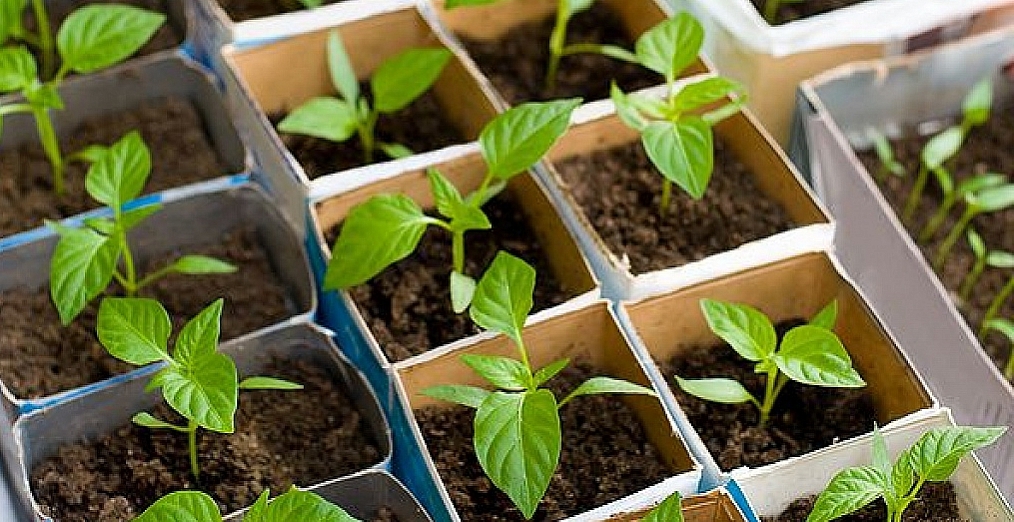Most farmers grow sweet pepper in their areas. In order for the culture to grow up healthy, and gives a good harvest, it is necessary to carry out proper landing and care.
Contents
- When they sow Bulgarian pepper for seedlings: preparation of seeds
- Sowing Bulgarian pepper for seedlings: how to sow seeds correctly?
- Planting Bulgarian pepper in open ground: Preparation of seedlings
- How to choose a place for planting the seedlings of Bulgarian pepper?
- What to put in a hole when planting seedlings of bell pepper, what fertilizers for the soil are needed?
- Is it possible to plant 2 pepper in the hole?
- Bulgarian pepper planting scheme in a greenhouse
- Planting Bulgarian pepper in open ground: scheme, basic rules
- Bulgarian pepper care after planting?
- How to form bushes of Bulgarian pepper?
- Diseases and pests of Bulgarian pepper
- Video: planting pepper seedlings, holes requirements
It is important to know what fertilizers to be added to the hole during landing. Read more about this in this article.
When they sow Bulgarian pepper for seedlings: preparation of seeds
- Bulgarian pepper is customary to plant with seedlings. If you buy it, you can skip this stage. If you plan to grow seedlings yourself, you first need prepare the seeds.
- Need to take it away strong and large seeds, on the surface of which there are no signs of diseases, cracks and other damage. After they need to be filled with hot water, and leave for 2-3 hours so that they swell.
- When the seeds become more, wrap them in wet fabric, and leave them for 2-3 days. This time is enough for the seeds to sprout. Only after the implementation of all of the above stages can you start sowing seeds in fertile soil.
- In order for the seedlings to be healthy and strong, it is necessary to prepare a nutritious soil mixture. You can buy it already ready in a specialized store, or cook it yourself. Mix to this humus, peat, earth and sand In equal proportions. To disinfect the soil, add a little wood ash. Carefully mix all the components, and place for 10-15 minutes. In the microwave or oven. You need to pump the soil at a temperature of +50 ° C.
- The seed sowing begins in second decade of March. This will allow the planting of the seedlings of Bulgarian pepper in May in May.
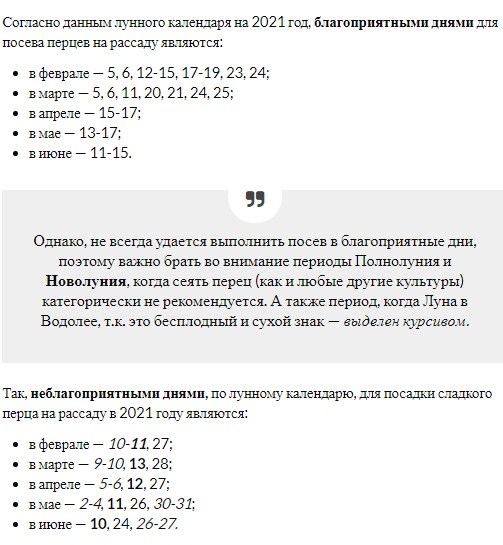
It should also be taken into account pepper variety. In March, early grades are sown. If you plan to grow a late variety of pepper, plant seeds in late February.
Sowing Bulgarian pepper for seedlings: how to sow seeds correctly?
- It is recommended that the sowing material of the Bulgarian pepper on seedlings is put in boxes for seedlings or special cassettes. It is best to use peat glassesTo reduce the likelihood of damage to the root system during diving.
- Fill the containers with nutrient soil, and deepen the seeds by 2 cm. Pour a small amount of water using the method sufferingand cover with polyethylene.
- Put containers in a warm sunny place. If there is not enough light in the room, install a daylight lamp nearby. Seeds germinate well at temperatures from +22 ° C to +24 ° C.
- When the first shoots appear, remove polyethylene, and increase the temperature in the room to +28 ° C. At night, it must be reduced to +16 ° C.
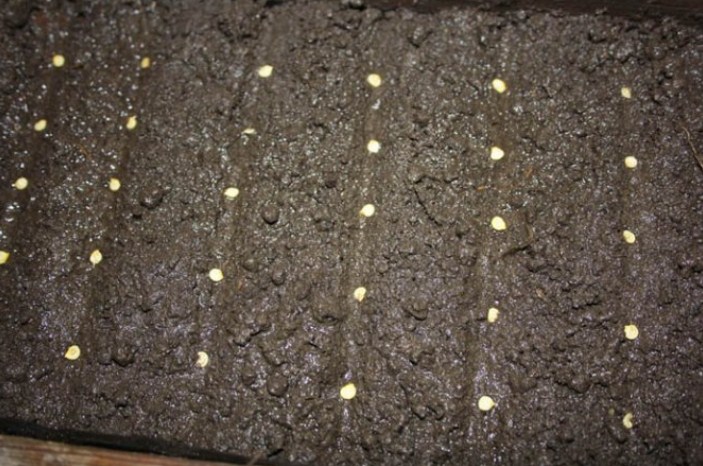
Planting Bulgarian pepper in open ground: Preparation of seedlings
- It is recommended to start planting the seedlings of Bulgarian pepper in a permanent place when the seedlings are formed on the seedlings 4-5 pairs of leaves. You can plant plants on which buds have already formed. If the seedlings began to bloom, it is not recommended to transplant it. Otherwise, culture will not be able to take root, and develop correctly.
- The terms of landing depend on the region of the country. The temperature from +15 ° C to +18 ° C. It is important that there is no return of frosts, because the culture will not develop.
The optimal terms for planting pepper in a permanent place is the end of May. At night, the air temperature decreases, which can negatively affect plants. Therefore, they should be covered with plastic film.
How to prepare seedlings:
- It is necessary to proceed with the preparation of seedlings of Bulgarian pepper 14 days before the alleged planting in open ground.
First, plants should be hardened. For this during the day they are kept at a temperature of +20 ° C, and at night - at +16 ° C.
- If the weather is sunny, you can take seedlings into the open air. In the first few days, place it in shaded areas, So that the sun's rays do not damage the leaves. Every day, increase the time of the seedlings in the air so that it is better acclimatized.
- 2-3 days before planting, remove the lower pair of leaves so that the seedlings take root better in open ground. A couple of days before planting, it is desirable to remove 1-2 lower leaves, this will help plants take root in a new place faster.
- 2-3 hours before landing, pour the plants with warm water.
- Seedlings are suitable for a permanent place, the height of which is about 20-30 cm. There must be a dense stalk, and formed single buds. The optimal age is 50-60 days.
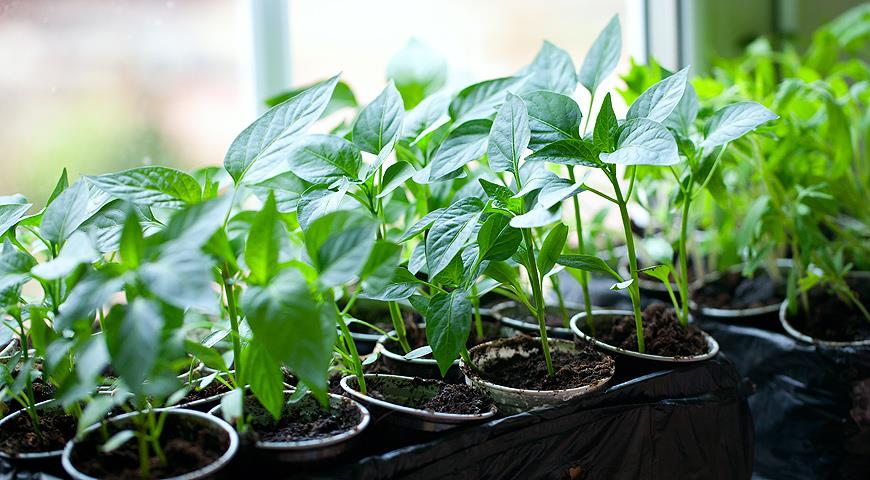
How to choose a place for planting the seedlings of Bulgarian pepper?
- Bulgarian pepper prefers to grow in areas that are well illuminated by sunlight, and protected from drafts. Before planting, make the beds high so that groundwater does not provoke rotting of the root system.
It is not recommended to plant pepper for 2 consecutive years in the same place. This will significantly reduce productivity. For the same reason, it is impossible to plant seedlings of peppers after tomatoes, eggplant and potatoes. It is better to give preference to areas where legumes, pumpkin and root crops, cabbage and cucumbers used to grow before.
- Dice the selected area in the fall, and add organic fertilizers. You can add a little superphosphate or potassium nitrate. Some gardeners prefer to strengthen the action of organic cultures of ammonia nitrate.
- Before planting pepper, the soil is disinfected by watering the site with a solution of copper sulfate (30 g per 10 l of water).
What to put in a hole when planting seedlings of bell pepper, what fertilizers for the soil are needed?
In order to collect a high -quality and rich crop at the end of the season, you will need to prepare a large number of fertilizers. They are introduced not only on the site, but also to each hole.
Substances in the soil:
- First you need to reduce the acidity of the soil.
- Lime should be carried out since autumn.
- If the procedure is carried out in the spring, this will negatively affect the development of culture, and reduce productivity.
To adjust the density and composition of the soil, such manipulations should be carried out:
- If the soil loamy, add humus, sand and rotted sawdust in equal proportions to it. On 1m 2 add 10 kg of the mixture;
- If the soil peat, bring river sand, turf soil and humus. On 1m 2 You need to use 10 kg of each component.
Spread the soil with rotten manure. The fresh component will make the soil too sour.
To disinfect the soil, a weak solution of manganese is poured into each hole. This is a great alternative to a copper sulfate that not every farmer has.
To improve fruiting and growing culture, the following components are added to the holes:
- Superphosphate. 0.5 tsp is added to each hole. Substances. It will allow you to form a strong root system, and accelerate growth.
- Wood ash. 1 component should account for 1 hole. It will reduce the acidity of the soil, and nourishes the plant with potassium, phosphorus and calcium. If in the fall you added slagged lime to the ground, add 2 tbsp. l. wood ash.
- Told manure. Only 200 g of component is enough.
- Shell on Luke. It must be soaked in boiling water, and poured onto the bottom of the hole. She will protect pepper from diseases and pests.
- Ammonium nitrate. Washing the plant with useful components, increasing the size of the pepper.
- Eggshell. It must be chopped, and throw 1-2 tbsp into each hole. l. She will protect the pepper from the bear, and will feed the plants with calcium.
Is it possible to plant 2 pepper in the hole?
According to statistics, it is better to put several peppers in one hole. This will increase productivity.
Among other advantages of steam landing, they highlight:
- The probability of taking into account. If one seed is damaged by the pest, then the second will necessarily take root;
- Seedlings are better kept, because two seedlings will support each other. In this case, the garter is not required;
- The best pollination occurs.
Do not plant seedlings of different varieties of Bulgarian pepper in one hole. Hybrids may form. Growth should be avoided in one root so that the fruits are large.
Bulgarian pepper planting scheme in a greenhouse
The benefits of planting pepper according to the scheme include:
- the site is more economical;
- plants develop correctly, which increases productivity;
- seedlings grow faster;
- the fruits rot less;
- facilitate the care process;
- optimal lighting of seedlings.
Planting schemes for the greenhouse and open soil are slightly different. More about this will be described later.
Scheme of planting Bulgarian pepper in a greenhouse:
If you put peppers in a polycarbonate greenhouse, adhere to such a scheme:
- 2 beds 100 cm wide;
- 3 beds 70 cm wide.
The distance between the bushes depends on the grown variety. Hybrids and varieties with high bushes are planted at a distance of 35 cm from each other. If you plant medium -sized varieties, you can adhere to a distance of 25 cm. For low -growing varieties, a distance of 15 cm between the bushes is suitable.
It is necessary to deepen seedlings so that only the root system is in the ground. If you hook the stem and leaves, the plant will develop poorly.
There are other schemes for planting Bulgarian pepper:
- Widely row. A distance of 25 cm is observed between the bushes, and 60 cm between the rows;
- Ribbon. Between the plants-25 cm, between the rows in the tape-30-45 cm, and between the ribbons-55 cm;
- Square-nesting. 2 bushes are planted in the hole, at a distance of 60 cm;
- Chess. Seedlings should be arranged in a checkerboard pattern, observing the scheme - 30x30 cm.
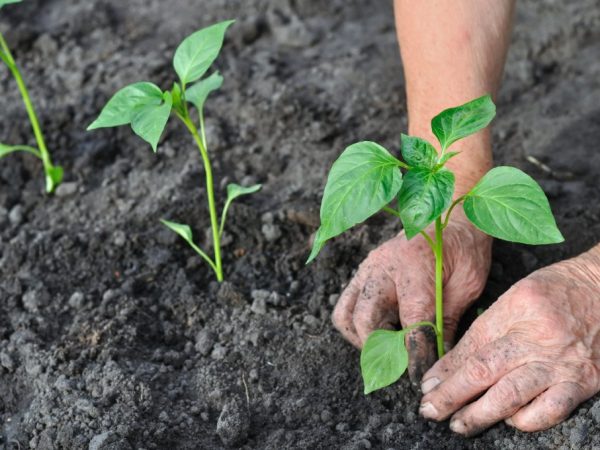
Planting Bulgarian pepper in open ground: scheme, basic rules
To collect a good harvest at the end of the season, adhere to such rules:
- Plant in the evening. Active sunlight provoke the lethargy of seedlings, and it will be a difficult task to restore it.
- Plant the plants after the rain. The soil will be moistened, which will accelerate the adaptation of seedlings.
- Pour the seedlings in containers so that it is easier to get it, and not damage the root system.
- Process the root system with a growth stimulant.
Optimal distance:
- If you plant Bulgarian pepper, adhere to the optimal distance between rows and bushes. So the plants will not be interrupted, and shade each other. This will positively affect yields.
- Between the rows there should be a distance of half a meter (subject to the planting of stunted varieties). If you plant volumetric bushes, increase the distance between rows to 30 cm.

It is practical to plant seedlings with beds. The larger its length, the easier it is to take care of culture. It is better to adhere to the landing scheme of 70x70 cm.
This is due to the following advantages:
- It is easier to feed under the root. The likelihood of damage to neighboring plants is reduced.
- It is easier to control the presence of fungal diseases, and fight them.
- It is easier to tie tall bushes.
- It is easier to water and irrigate plants.
- Free access for the loosening of soil and the removal of weeds.
How to plant pepper in open ground, scheme:
- After the holes are prepared, you can mark the site. If tall varieties or hybrids are grown, the distance is observed between the bushes 45-50 cm.
- For medium-sized varieties, 30-35 cm is enough, and for low-growing-20 cm. The inter-row space should be at least 65 cm.

Step -by -step instructions for planting Bulgarian pepper in open ground:
- Dig the holes 30 cm deep. If tall varieties are grown, install pegs with a height of 70 cm next to each hole.
- Pour into the hole fertilizersAnd pour a little warm water.
- Place seedlings inside, and sprinkle with the soil.
- Pour a small amount of water.
How to plant pepper in warm beds?Planting technology:
- Make a box 100 cm wide, and 40 cm high. Determine the length yourself.
- At the bottom, put a sheet of cardboard to prevent the development of weeds.
- On top of the paper, put branches of trees, corn stems and sunflower.
- The next layer is grass and cabbage leaves.
- Pour warm water and compact.
- Put the fallen leaves on top, and sprinkle them with the soil. The optimal soil height is 15 cm.
- Pour the hole with a potassium mortar.
- Place seedlings in the hole, sprinkle with earth, and pour.
Bulgarian pepper care after planting?
Care for sweet pepper involves compliance with such stages:
- Proper watering. Conduct it in the morning or in the evening;
- Top dressing with an interval of 2 weeks;
- Treatment of plants from diseases and pests;
- Loosening of the soil. 2 days after watering and fertilizers, loosen the upper layer of soil so as not to provoke root rot. So plants will receive more oxygen;
- Mulching. After planting, the land around the bush is covered with straw, hay or peat, in order to preserve the optimal level of humidity in the soil, and prevent the development of weeds;
- Removing weeds. Every 3-5 days, inspect the site and remove weeds. They will slow down the development of pepper;
- Garter. If the bushes are tall, the support is installed next to them, and the plant is tied to it. Then the peppers are not deformed.
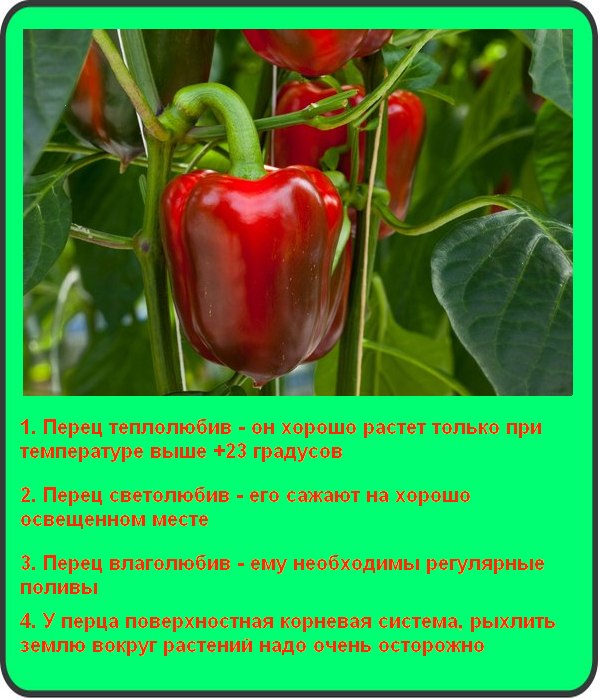
Watering Bulgarian pepper:
- You must not allow the soil to dry out. Therefore, irrigation is recommended to irrigate 2-3 times a week, depending on the growing region.
- Pepper loves sprinkling. But, the procedure must be carried out when there are no direct sunlight. Survation is carried out in the morning or in the evening, so that they do not appear on the leaves on the leaves.
On 1m 2 It is necessary to pour at least 30 liters of water.
Feeding of seedlings of Bulgarian pepper:
- Nutrients are introduced in several stages. For the first time, pepper is fed during the seedling period, when the first pair of leaves is formed.
- During this period, a solution of ammonium nitrate, superphosphate and potassium fertilizers. After 14 days, you can repeat top dressing using mineral components. You can also use a mixture of water and nettles. The last top dressing is carried out 2-3 days before planting permanently. At this moment, potassium sulfate is introduced.
- 10 days after planting Bulgarian pepper in open ground, you need to feed the plants A mixture of mineral and organic fertilizers. During this period, it is allowed to make chicken labels and humus. In order for the plant to grow green mass, a solution of nitrogen fertilizers is used. You can add nitrofosk to the solution, and pour it under the root.
- The next top dressing is carried out during flowering pepper. Now it is advisable to use wood ash rich in potassium. The basal part can be sprinkled with ash. Instead, you can use a solution from humus, chicken and urea. 1 kg of substances is diluted in 10 liters of water, and each bush of 1.5 l of the prepared liquid is watered.
- To stimulate the growth of seedlings, use potassium salt and superphosphate. The solution is prepared from these components, and plants are sprayed.

How to form bushes of Bulgarian pepper?
To improve ventilation and light level between plants, it is necessary to form bushes. If the variety is tall, unnecessary shoots are removed. To stop growth, pinch the top. If the bushes are stunted, cut off the lower shoots, and the branches on which the fruits are not formed.
The main recommendations for the formation of a pepper bush:
- When fruitful branches begin to grow, remove the crown bud located between the nodes. It is to improve the development of branches.
- Only leave on the bushes 2 main shoots, So that the rest do not take a lot of nutrients.
- Remove the lower leaves to improve ventilation.
- Remove yellow and damaged leavesso that they do not carry the disease.
- Only 18 colors are left on the bushes, and the rest are cut off. This will preserve the optimal amount of nutrients, and increase the size of the fruit.
Diseases and pests of Bulgarian pepper
- Often Bulgarian pepper is more fitophthrosis. Dark spots appear on the fruits. To combat the disease use "Zaslon" and "barrier". If you notice yellowness on the leaves of plants, there is a great probability of the development of fusariosis. Such bushes must be removed with the roots. If dark purple spots appear on the leaves, the reason lies in the bronze or spotted wilting. A fungal disease is treated "Fundazole."
- Black spots on the fruits indicate development Verrini rot. It develops because of excess of nitrogen and calcium. The affected plants must be removed along with the roots.
- If you plant the bushes too close to each other, the stems will degenerate and break off. This speaks of such a disease as blackleg. It is impossible to cure it. We will have to completely eradicate the affected plants.
- Of the pests that appear on the pepper, you should highlight aphid, spider mite, slugs and wireworms. All of them affect plants differently. Wirefront Desters the root system. Around the plant you need to dig the soil, and place sweet fruits around the entire perimeter. After the pest is collected manually, and is destroyed.
- In order to get rid of slugs, sprinkle the chopped nut or ground pepper around the site.
- To prevent the appearance bear, During planting into the holes, pour onion infusion.
- To fight with aphids A mixture of water and milk serum will help. A mixture of liquid soap, chopped onion and dandelion leaves helps to fight with a spider mite.
As you can see, there is nothing complicated in growing Bulgarian pepper. If you follow all the rules for preparing, planting and care, then at the end of the season you can collect a large number of large and juicy fruits.
Topics for gardeners - what they put in a hole when landing:

